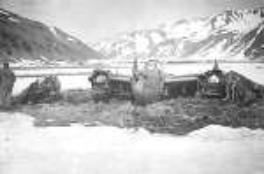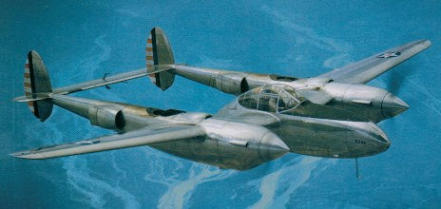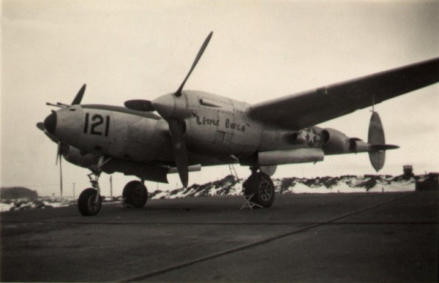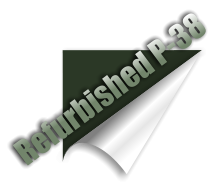

The Aleutians

The Lands of 50 mph Fog
© HLSWILLIWAW.COM
Built with XARA
P-38 “Lightning”


Dan Lange's "Little Butch." Shemya, AK. 1945

Attu's P-38 Tail # 13400, 1945
by E. A. McBride
The Lockheed P-38 Lightning, in addition to being Lockheed's first venture into the world of high performance military aircraft,
was one of the finest WWII fighters produced. Lockheed responded to the USAAC's 1937 Request for Proposals (RFP) for a
long-range interceptor with a twin-boom and central nacelle layout called the XP-38. Lockheed utilized butt-joined and flush-
riveted all-metal skins (and flying surfaces) in the aircraft's construction. This was a first for a US fighter plane.
The nickname "Lightning" was given to the P-38 by the RAF when the aircraft was ordered by them in 1940. The Americans
adopted the same name the following year.
The first P-38 production runs sold to the British did not include a supercharger fitted to their Allison V-1710 engines. The
supercharger (turbocharger) was deemed to be classified equipment by the U.S. Government, and was thus restricted from
overseas sales. These P-38's performed poorly, resulting in the order for 667 additional P-38s being cancelled by the RAF.
P-38 models E, F, H, J, and L were fitted with turbocharged engines, improved Fowler flaps and additional fuel capacity. These
P-38s proved to be more than a match for Axis fighters across the globe.
This fighter filled many diverse roles. In addition to its primary role as a fighter aircraft, it was used for photo reconnaissance
(F-4 & F-5), as a night fighter with added radar and a second crew member, an ambulance, a torpedo-bomber, and as a target
tug. It made its first flight on January 27, 1939 from designs dating back to 1937. There were 9,924 of all versions of this aircraft
produced.
First Flight Date: 27 January 1939
Type: Single-seat fighter and fighter-bomber
Powerplant(s): Two turbocharged Allison 1,427 hp V-1710-89/91 (P-38J) or two 1600 hp V-1710-111/113 (P-38L/M) in-line piston
engines.
Max Speed: 414 mph at 25,000 ft.
Range: 475 miles with internal fuel tanks, 2600 miles with improved fuel capacity tanks.
Service ceiling: 44,000 ft.
Weapons: One 20 mm cannon and four 0.50 cal. machine guns, plus up to 3,190 lbs of ordnance - usually two 1,000 lb or 1,600
lb bombs or 10x127 mm high-explosive rocket projectiles under the wings.
Weights: Empty 12,780 lbs; loaded (Max Take-off Weight) 21,600 lbs.
Dimensions:
Wing Span: 52 ft 0 inches.
Wing Area: Approx. 327 sq. ft.
Length: 37 ft 10 inches.
Height: 9 ft 10 inches.
The P-38 was the first American Army Air Corps fighter able to exceed speeds of more than 400 mph. The twin turbocharged
engines gave it superb high-altitude performance, and at altitudes above 26,000 feet was one of the world's best fighters.
The concentration of weaponry in the P-38's nose allowed it to bring immense firepower to bear on targets at all ranges.
Lightnings could saw Japanese Zeros in half, or completely severe an enemy aircraft's wing with a long burst of fire.
Ref: 1) Jane's Historic Military Aircraft 2) Aircraft of the World
Current Update: 07 Dec 2021 12:10



The Aleutians

The Lands of 50 mph Fog
P-38 “Lightning”


Dan Lange's "Little Butch." Shemya, AK. 1945

Attu's P-38 Tail # 13400, 1945
by E. A. McBride

The Lockheed P-38 Lightning, in addition to being Lockheed's
first venture into the world of high performance military aircraft,
was one of the finest WWII fighters produced. Lockheed
responded to the USAAC's 1937 Request for Proposals (RFP) for
a long-range interceptor with a twin-boom and central nacelle
layout called the XP-38. Lockheed utilized butt-joined and flush-
riveted all-metal skins (and flying surfaces) in the aircraft's
construction. This was a first for a US fighter plane.
The nickname "Lightning" was given to the P-38 by the RAF when
the aircraft was ordered by them in 1940. The Americans adopted
the same name the following year.
The first P-38 production runs sold to the British did not include a
supercharger fitted to their Allison V-1710 engines. The
supercharger (turbocharger) was deemed to be classified
equipment by the U.S. Government, and was thus restricted from
overseas sales. These P-38's performed poorly, resulting in the
order for 667 additional P-38s being cancelled by the RAF.
P-38 models E, F, H, J, and L were fitted with turbocharged
engines, improved Fowler flaps and additional fuel capacity.
These P-38s proved to be more than a match for Axis fighters
across the globe.
This fighter filled many diverse roles. In addition to its primary
role as a fighter aircraft, it was used for photo reconnaissance (F-
4 & F-5), as a night fighter with added radar and a second crew
member, an ambulance, a torpedo-bomber, and as a target tug. It
made its first flight on January 27, 1939 from designs dating back
to 1937. There were 9,924 of all versions of this aircraft produced.
First Flight Date: 27 January 1939
Type: Single-seat fighter and fighter-bomber
Powerplant(s): Two turbocharged Allison 1,427 hp V-1710-89/91
(P-38J) or two 1600 hp V-1710-111/113 (P-38L/M) in-line piston
engines.
Max Speed: 414 mph at 25,000 ft.
Range: 475 miles with internal fuel tanks, 2600 miles with
improved fuel capacity tanks.
Service ceiling: 44,000 ft.
Weapons: One 20 mm cannon and four 0.50 cal. machine guns,
plus up to 3,190 lbs of ordnance - usually two 1,000 lb or 1,600 lb
bombs or 10x127 mm high-explosive rocket projectiles under the
wings.
Weights: Empty 12,780 lbs; loaded (Max Take-off Weight) 21,600
lbs.
Dimensions:
Wing Span: 52 ft 0 inches.
Wing Area: Approx. 327 sq. ft.
Length: 37 ft 10 inches.
Height: 9 ft 10 inches.
The P-38 was the first American Army Air Corps fighter able to
exceed speeds of more than 400 mph. The twin turbocharged
engines gave it superb high-altitude performance, and at altitudes
above 26,000 feet was one of the world's best fighters.
The concentration of weaponry in the P-38's nose allowed it to
bring immense firepower to bear on targets at all ranges.
Lightnings could saw Japanese Zeros in half, or completely
severe an enemy aircraft's wing with a long burst of fire.
Ref: 1) Jane's Historic Military Aircraft 2) Aircraft of the World
Current Update: 07 Dec 2021 12:10
© HLSWILLIWAW.COM
Built with XARA



























